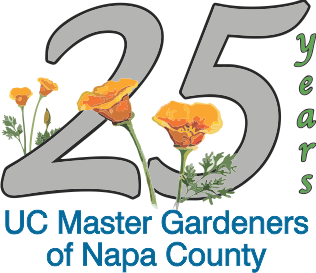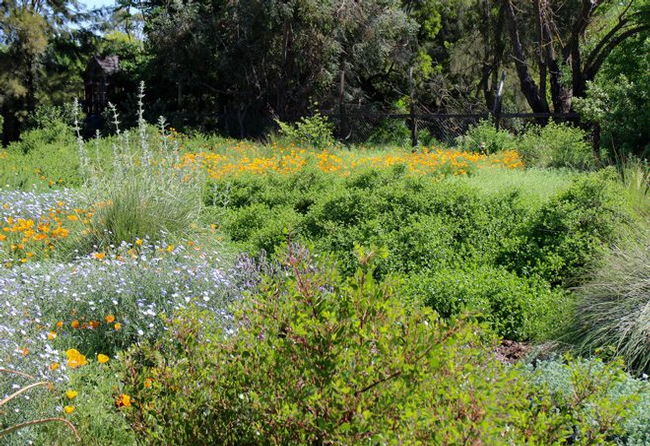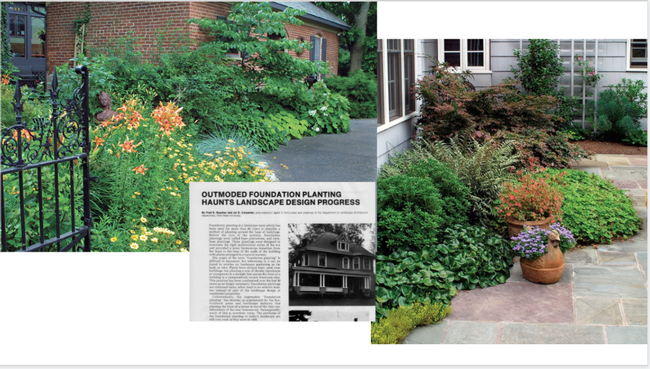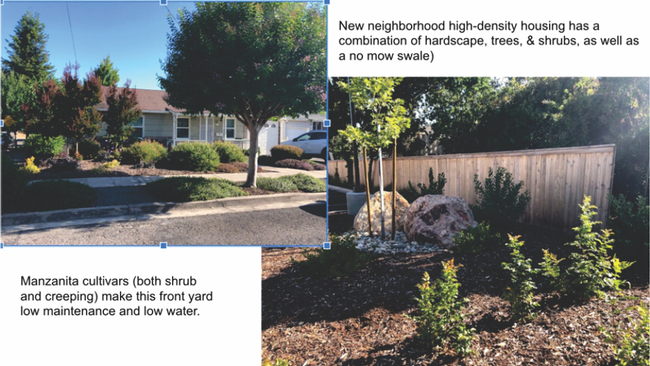Following is a summary of a Library Talk by UC Master Gardeners on July 2, 2020.
by Carrie Strohl

When preparing to “grow dry” prepare to rethink your garden aesthetic. Growing dry is a commitment, so be sure to consult many resources and set a budget before you begin. Consider what your home landscape says about what you value. What my neighbor may see as a weedy tangle on my curbside strip each spring I know is actually a pollinator friendly barrage of native wildflowers that self sow each year. Eventually they dry out, and yes, they look a little messy, but they provide forage for native bees, mating cover for beneficial insects, and seeds for birds.

In 2010 we became one of the first City of Napa “cash-for-grass” adopters. We chose drought-tolerant plants, but if I had known then about “no mow” grass, I would have taken that route. Clumping varieties like fescue are becoming increasingly popular. If you have a small amount of space, sowing grasses from seed can be very easy (bulk purchase is available from local nurseries).
Some of you may be thinking but what about the kids and the dogs who like to play on the lawn? Kids and dogs will like no-mow grass just as much as a cut lawn. I actually think it's more aesthetically balanced, providing a much more natural transition from grass to shrubs than the typical “foundational plantings” that typically separate lawn from house.
When planted close together, perennial/no-mow/native grasses cover the ground, shielding the surface from evaporation. They'll also grow in part shade, but wait! There's more...as science and agriculture tackles twin enemies of soil erosion and carbon release caused by tilling, researchers have discovered that the roots of native perennials grow much deeper and wider than annual grasses, thus have access to water and nutrients often depleted in the first layer of topsoil. So when you think about ditching the lawn, look at the good you can do besides saving water (like sequester carbon and improve soil health)!

In contrast to many trees or shrubs, native plants do not need inputs like compost and amendment when planting because they are already adapted to live in the soil types we have. However, it's still important to plant the right plant in the right place, so don't plant a bunch of low water plants near an area that gets regular water (like a lawn). They won't be happy, especially if they've already gone dormant! When I buy native plants, I check to see what “plant community” they belong to and select the just right plant for the area I want to add plants to. However, with well- established natives, minimal watering will keep them flourishing longer (prolonging the onset of dormancy).

Conserving water in your existing landscape can be achieved through diversified irrigation. Just as my neighbor frowns upon my native landscape, I scoff at his oscillating sprinkler in the summer. Of course, drip irrigation is one of the most efficient ways to keep gardens lush, but these systems are often costly and require ongoing maintenance. I choose to grow vegetables in galvanized water troughs, so drip irrigation is not the most practical solution. Instead, I use ancient technology: buried terra cotta pots called “ollas.” I fill them about once a week. Not only do these keep the water from leaching out of these tubs, they also lower the ambient temperature (those steel tubs can get hot!).
With the support of the Napa County RCD, we had a laundry-to-landscape greywater system professionally installed in 2016. This system of buried mulch basins slows, spreads, and sinks water in a way that replenishes groundwater supply, while giving a few natives occasional water.
Although I love succulents, especially aeoniums, they don't tolerate the cold snaps in my backyard. In addition, they often require significant soil amendment to mitigate drainage in Napa clay soils. Other than the tubular flowers of some aloes and agaves, they don't provide much in the way of habitat. You can have a dry garden without cactus, succulents, or xeriscaping by selecting drought-tolerant natives.
To get more design ideas, view this presentation or visit the City of Napa's website. Teaming with other local agencies, they sponsor Free Water-Wise Landscaping Workshops made possible by the expertise of the UC Master Gardeners, the California Native Plant Society (CNPS) Napa Valley Chapter, the Napa County Resource Conservation District (RCD), and area professionals.. Water conservation is a way of life in California.
Resource List for Dry Gardening Library Talk 7-2-2020
Information Resources (How-to, Plant Choices, etc.)
- Bay Area Gardening
- City of Napa Water-Wise Landscaping
- Water Conservation State of California
- UC Master Gardeners Santa Clara
- Sierra Club:The Art of the Dry Garden
- Dry Garden Plans: The Old Farmer's Almanac
- Pacific Horticulture: Dry Gardening Handbook
- Gardenista: Low Water Landscapes
- WUCOLS: https://ucanr.edu/sites/WUCOLS/
- Plant a No-Mow Lawn
Design Resources
- Contra Costa Water-Wise Garden
- Sonoma-Marin Water Saving Partnership
- South Bay Area Green Garden Designs
- Sunset Western Garden Magazine
Commercial Resources
- California Native Plant Society Napa Valley Chapter
- Source for Native Grass: Delta Bluegrass Co.
- UC Davis Arboretum
Master Gardeners are following recommended social distancing guidelines that keep everyone safe, Napa Master Gardeners are available to answer garden questions by email: mastergardeners@countyofnapa.org. or phone at 707-253-4143. Volunteers will get back to you after they research answers to your questions.
Visit our website: napamg.ucanr.edu to find answers to all of your horticultural questions.
Photo credits: top, Pacific Horticulture, 2nd, 3rd, Public Domain, 4, 5, Carrie Strohl